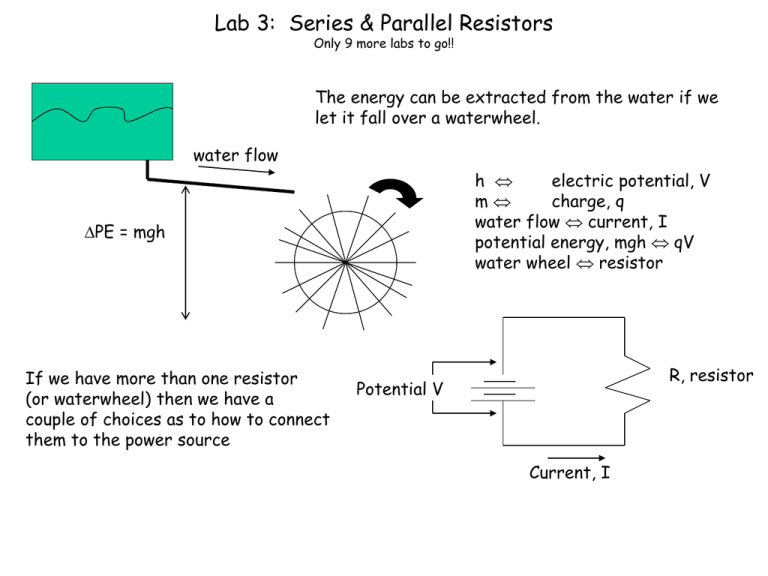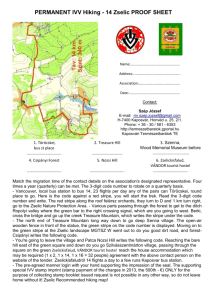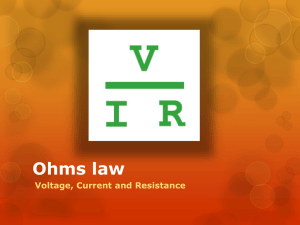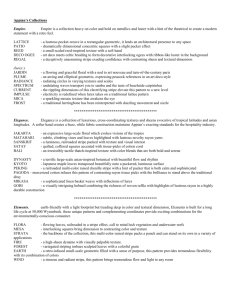Powerpoint Slides
advertisement

Lab 3: Series & Parallel Resistors Only 9 more labs to go!! The energy can be extracted from the water if we let it fall over a waterwheel. water flow h electric potential, V m charge, q water flow current, I potential energy, mgh qV water wheel resistor PE = mgh If we have more than one resistor (or waterwheel) then we have a couple of choices as to how to connect them to the power source R, resistor Potential V Current, I We could connect them in series • The current through each wheel (resistor) is the same • The height drop (potential energy, voltage) across each wheel (resistor) will add to the total height (total voltage) water flow V1 I I htotal h2 V2 VTotal h1 R1 R2 I • The total resistance of the circuit, as felt by the battery will be the sum of all individual resistances RTotal = R1 + R2 We could connect them in Parallel ITotal I1 I2 V V R1 I1 h V R2 I2 ITotal • The current that flows through each resistor will add up to the total delivered by the power source • The electric potential (voltage) will be the same across each resistor • The total resistance seen by the power supply will always be less than any individual resistor 1 RTotal 1 1 R1 R2 Circuit analysis, you will be asked to do circuit analysis on the quiz. Consider the following circuit: R1 = 50 R2 = 75 R3 = 25 V = 10 V R4 = 10 Let’s find the voltage drop across each resistor. The 1st step is to reduce the circuit to an equivalent resistance. V = 10 V R12 = 125 R12 = R1 + R2 = 50 + 75 R34 = 7.1 1 1 1 1 1 14 R34 R3 R4 25 10 100 Take one over! DON’T FORGET! IT = 0.076 A V = 10 V R1234 = 132.1 R1234 = R12 + R34 = 125 + 7.1 Using Ohm’s law we can calculate the current through the circuit: V 10V IT 0.076 A R 132.1 Next we can calculate the voltage drop across the two equivalent resistors, R12 and R34 IT = 0.076 A V = 10 V R12 = 125 V12 = 9.5 V V12 = IT R12 = (0.076 A) (125 ) = 9.5 V R34 = 7.1 V34 = 0.54 V V34= IT R34= (0.076 A) (7.1 ) = 0.54 V Finally we can find the voltage dropped across each resistor V1 = IT R1 = (0.076 A)(50 ) = 3.8 V R1 = 50 V2 = IT R2 = (0.076 A)(75 ) = 5.7 V R2 = 75 V2 = 5.7 V IT = 0.076 A V1 = 3.8 V R3 = 25 V3 = 0.54 V V = 10 V R4 = 10 V4 = 0.54 V How could we measure the voltages and currents? We need to use Voltmeters (connected in parallel) for the voltage and Ampmeters (connected in series) to measure the current Measuring current through R1 and R2 R1 = 50 R2 = 75 Amp Series V = 10 V R3 = 25 Amp Series R4 = 10 Volts Parallel Measuring the voltage across R3 and R4 Measuring current through R3 To calculate the value of a resistor using the color coded stripes on the resistor, use the following procedure. Step One: Turn the resistor so that the gold or silver stripe is at the right end of the resistor. Step Two: Look at the color of the first two stripes on the left end. These correspond to the first two digits of the resistor value. Use the table given below to determine the first two digits. Step Three: Look at the third stripe from the left. This corresponds to a multiplication value. Find the value using the table below. Step Four: Multiply the two digit number from step two by the number from step three.This is the value of the resistor n ohms. The fourth stripe indicates the accuracy of the resistor. A gold stripe means the value of the resistor may vary by 5% from the value given by the stripes. Color 1st Stripe 2nd Stripe 3rd Stripe Black 0 0 x1 Brown 1 1 x10 Red 2 2 x100 Orange 3 3 x1,000 Yellow 4 4 x10,000 Green 5 5 x100,000 Blue 6 6 x1,000,000 Purple 7 7 Gray 8 8 White 9 9 4th Stripe Gold 5% Silver 10% Example1: You are given a resistor whose stripes are colored from left to right as brown, black, orange, gold. Find the resistance value. Step One: The gold stripe is on the right so go to Step Two. Step Two: The first stripe is brown which has a value of 1. The second stripe is black which has a value of 0. Therefore the first two digits of the resistance value are 10. Step Three: The third stripe is orange which means x 1,000. Step Four: The value of the resistance is found as 10 x 1000 = 10,000 ohms (10 kilohms = 10 kohms). The gold stripe means the actual value of the resistor mar vary by 5% meaning the actual value will be somewhere between 9,500 ohms and 10,500 ohms. (Since 5% of 10,000 = 0.05 x 10,000 = 500) Example2: You are given a resistor whose stripes are colored from left to right as orange, orange, brown, silver. Find the resistance value. Step One: The silver stripe is on the right so go to Step Two. Step Two: The first stripe is orange which has a value of 3. The second stripe is orange which has a value of 3. Therefore the first two digits of the resistance value are 33. Step Three: The third stripe is brown which means x 10. Step Four: The value of the resistance is found as 33 x 10 = 330 ohms. The silver stripe means the actual value of the resistor mar vary by 10% meaning the actual value will be between 297 ohms and 363 ohms. (Since 10% of 330 = 0.10 x 330 = 33) Example3: You are given a resistor whose stripes are colored from left to right as blue, gray, red, gold. Find the resistance value. Step One: The gold stripe is on the right so go to Step Two. Step Two: The first stripe is blue which has a value of 6. The second stripe is gray which has a value of 8. Therefore the first two digits of the resistance value are 68. Step Three: The third stripe is red which means x 100. Step Four: The value of the resistance is found as 68 x 100 = 6800 ohms (6.8 kilohms = 6.8 kohms). The gold stripe means the actual value of the resistor mar vary by 5% meaning the actual value will be somewhere between 6,460 ohms and 7,140 ohms. (Since 5% of 6,800 = 0.05 x 6,800 = 340) Example 4: You are given a resistor whose stripes are colored from left to right as green, brown, black, gold. Find the resistance value. Step One: The gold stripe is on the right so go to Step Two. Step Two: The first stripe is green which has a value of 5. The second stripe is brown which has a value of 1. Therefore the first two digits of the resistance value are 51. Step Three: The third stripe is black which means x 1. Step Four: The value of the resistance is found as 51 x 1 = 51 ohms. The gold stripe means the actual value of the resistor mar vary by 5% meaning the actual value will be somewhere between 48.45 ohms and 53.55 ohms. (Since 5% of 51 = 0.05 x 51 = 2.55)






